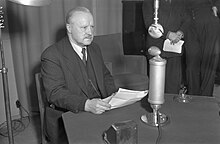
The Continuation War, also known as the Second Soviet-Finnish War, was a conflict fought by Finland and Nazi Germany against the Soviet Union during World War II. It began with a Finnish declaration of war and invasion on 25 June 1941 and ended on 19 September 1944 with the Moscow Armistice. The Soviet Union and Finland had previously fought the Winter War from 1939 to 1940, which ended with the Soviet failure to conquer Finland and the Moscow Peace Treaty. Numerous reasons have been proposed for the Finnish decision to invade, with regaining territory lost during the Winter War regarded as the most common. Other justifications for the conflict include Finnish President Risto Ryti's vision of a Greater Finland and Commander-in-Chief Carl Gustaf Emil Mannerheim's desire to annex East Karelia.

The Winter War was a war between the Soviet Union and Finland. It began with a Soviet invasion of Finland on 30 November 1939, three months after the outbreak of World War II, and ended three and a half months later with the Moscow Peace Treaty on 13 March 1940. Despite superior military strength, especially in tanks and aircraft, the Soviet Union suffered severe losses and initially made little headway. The League of Nations deemed the attack illegal and expelled the Soviet Union.

Risto Heikki Ryti was a Finnish politician who served as the fifth president of Finland from 1940 to 1944. Ryti started his career as a politician in the field of economics and as a political background figure during the interwar period. He made a wide range of international contacts in the world of banking and within the framework of the League of Nations. Ryti served as prime minister during the Winter War and the Interim Peace, and as president during the Continuation War.
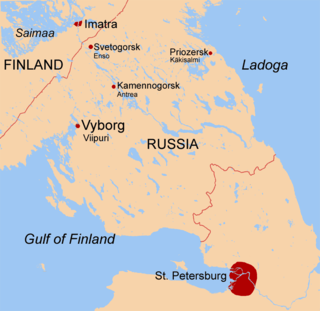
The Karelian Isthmus is the approximately 45–110-kilometre-wide (30–70 mi) stretch of land situated between the Gulf of Finland and Lake Ladoga in northwestern Russia, to the north of the River Neva. Its northwestern boundary is a line from the Bay of Vyborg to the westernmost point of Lake Ladoga, Pekonlahti. If the Karelian Isthmus is defined as the entire territory of present-day Saint Petersburg and Leningrad Oblast to the north of the Neva and also a tiny part of the Republic of Karelia, the area of the isthmus is about 15,000 km2 (5,800 sq mi).

The Karelo-Finnish Soviet Socialist Republic, also called Soviet Karelia or simply known as Karelia, was a republic of the Soviet Union. It existed from 1940 until it was made part of the Russian SFSR in 1956 as the Karelian Autonomous Soviet Socialist Republic. The latter became the Republic of Karelia, a federal subject of Russia, on 13 November 1991.
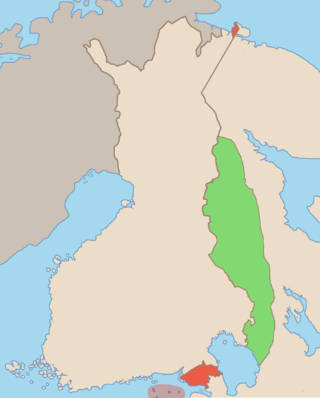
The Finnish Democratic Republic, also known as the Terijoki Government, was a short-lived communist puppet state of the Soviet Union in occupied Finnish territory from December 1939 to March 1940.

Karelia is an area in Northern Europe of historical significance for Russia, Finland, and Sweden. It is currently divided between northwestern Russia and Finland.

Finland participated in the Second World War initially in a defensive war against the Soviet Union, followed by another, this time offensive, war against the Soviet Union acting in concert with Nazi Germany and then finally fighting alongside the Allies against Germany.

The Karelian question or Karelian issue is a dispute in Finnish politics over whether to try to regain control over eastern Karelia and other territories ceded to the Soviet Union in the Winter War and the Continuation War. Despite the name "Karelian question", the term may refer also to the return of Petsamo, ceded parts of Salla and Kuusamo, and four islands in the Gulf of Finland. Sometimes the phrase "debate on the return of the ceded territories" is used. The Karelian question remains a matter of public debate rather than a political issue.

The Battle of Petsamo was fought between Finnish and Soviet troops in the area of Petsamo in the far north of Finland in 1939 and 1940. The Finnish troops were greatly outnumbered but managed to contain the Soviet troops due to the extreme terrain, weather and leadership.
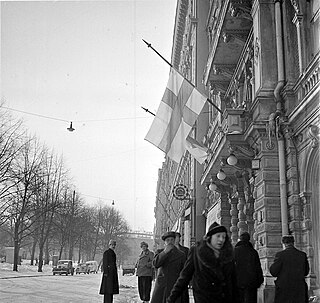
The Interim Peace was a short period in the history of Finland during the Second World War. The term is used for the time between the Winter War and the Continuation War, lasting a little over 15 months, from 13 March 1940 to 24 June 1941. The Moscow Peace Treaty was signed by Finland and the Soviet Union on 12 March 1940 and it ended the 105-day Winter War.

The Moscow Armistice was signed between Finland on one side and the Soviet Union and United Kingdom on the other side on 19 September 1944, ending the Continuation War. The Armistice restored the Moscow Peace Treaty of 1940, with a number of modifications.
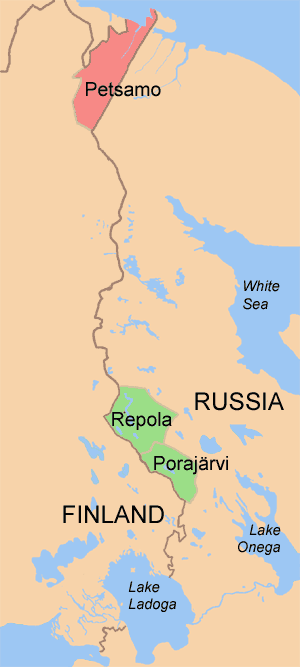
The Treaty of Tartu was signed on 14 October 1920 between Finland and Soviet Russia after negotiations that lasted nearly five months. The treaty confirmed the border between Finland and Soviet Russia after the Finnish Civil War and Finnish volunteer expeditions in Russian East Karelia that resulted in annexation of several Russian districts.

The old Karelian railroad between Viipuri and Joensuu was a 1,524 mm broad gauge line that used to link Joensuu, Sortavala, Hiitola, Antrea and Viipuri. Originally built in 1892-1894 by Finnish State Railways in the Grand Duchy of Finland, in the 1940s most of the railway up to Niirala was ceded by Finland to the Soviet Union in the Moscow Peace Treaty, Moscow Armistice and Paris Peace Treaty as a result of the Winter War and Continuation War. Now the track is located in Leningrad Oblast, Republic of Karelia and North Karelia. The Sortavala–Joensuu link across the border was abolished after the Continuation War, but was since restored and is currently in use for cargo traffic.

Viipuri Province was a historical province of Finland from 1812 to 1945.
The Province of Petsamo was a Finnish panhandle. It was a separate province from 1921 to 1922, when it was merged into the Province of Oulu. This panhandle used to give Finland access to the Arctic Ocean, until it was annexed by the Soviet Union in 1944.
The background of the Winter War covers the period before the outbreak of the Winter War between Finland and the Soviet Union (1939–1940), which stretches from the Finnish Declaration of Independence in 1917 to the Soviet-Finnish negotiations in 1938–1939.
The timeline of the Winter War is a chronology of events leading up to, culminating in, and resulting from the Winter War. The war began when the Soviet Union attacked Finland on 30 November 1939 and it ended 13 March 1940.

Hanko Naval Base was a Soviet naval base from 1940 to 1941 in the town of Hanko at the Hanko Peninsula, which is located 100 kilometers (62 mi) from Helsinki, the Finnish capital.

The borders of Finland are the dividing lines between it and the neighbouring countries of Norway, Russia and Sweden. The total length of land borders of Finland is 2,563 km / 1593 mi.

